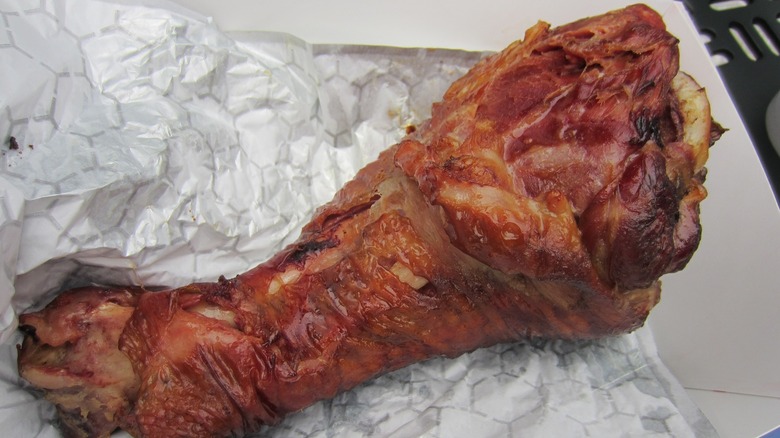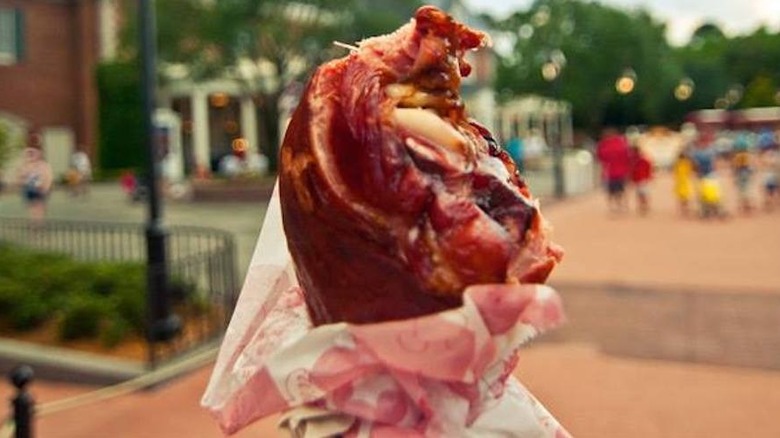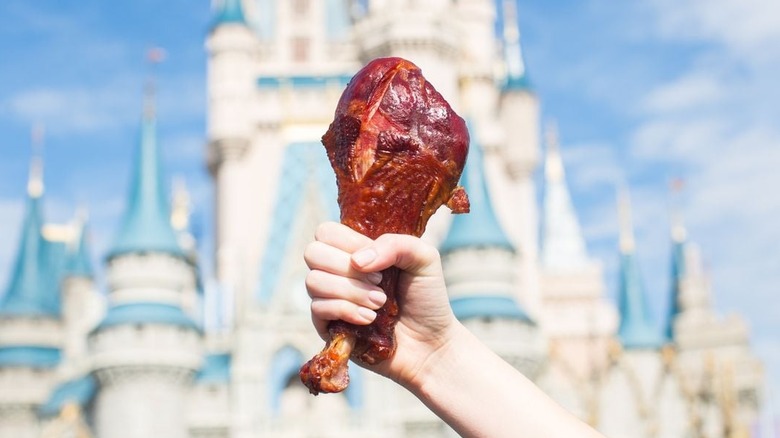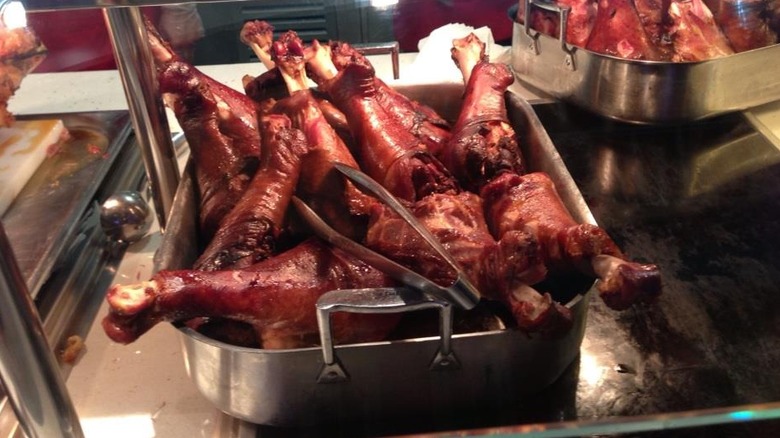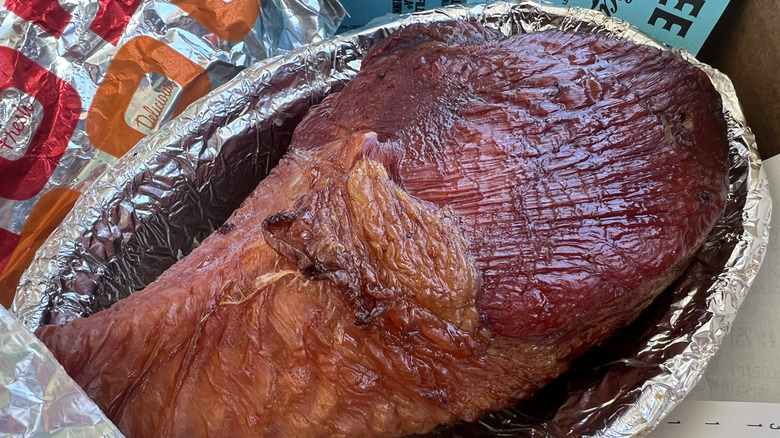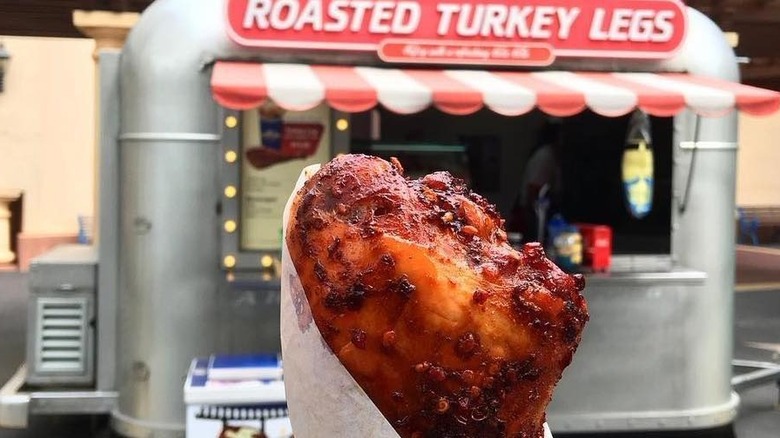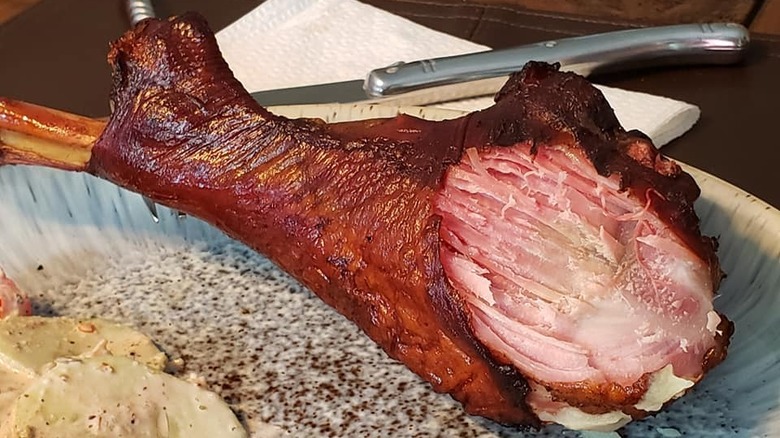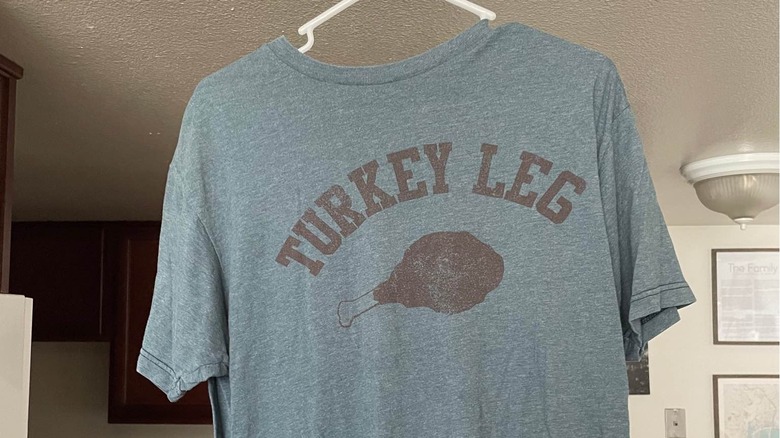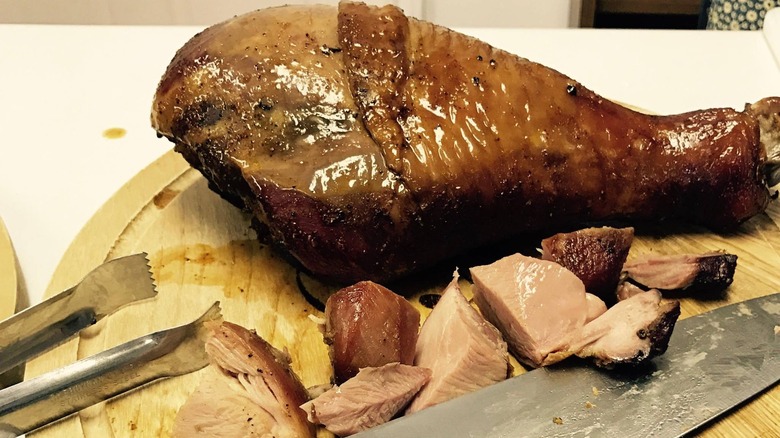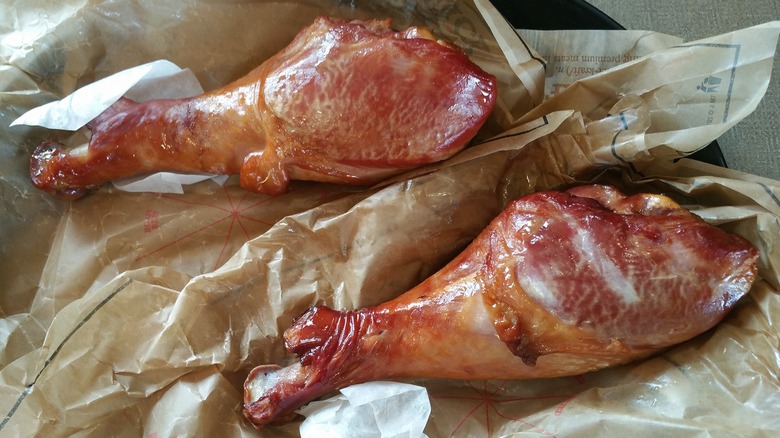The Untold Truth Of Turkey Legs
Few food items are as polarizing as the turkey leg — it is a true "love it" or "hate it" situation. On one end of the spectrum, its beloved admirers can't get enough of the generously portioned, sodium-laced, portable food. On the other hand, its haters really know how to hate — knocking its large, often grotesque appearance and the astonishing amounts of calories, fat, and God knows what else you're ingesting in one seating. Haters gonna hate, right?
Whether you have tried one or been an innocent bystander, the sight of a turkey leg has likely been burned into your mind forever. You just can't unsee the thing. The turkey leg has its place in many amusement parks, county fairs, and festivals across the country. There's even a holiday dedicated to it (okay, all turkey products really) each year when its faithful admirers rally together for National Turkey Lovers Day. On paper, it is a snack — or meal (because, let's be honest, it's huge) — comprised mostly of protein from the aforementioned animal. So, why does the bird get so much heat? Join us on this brine-filled adventure of fat, fun, and fairs. This is the untold truth of the turkey leg.
The turkey leg's origins are in medieval times (but not what you may think)
There's a lot that could be attributed to medieval times — the time period from the 5th to the late 15th centuries also known as the Middle Ages. We have them to thank for countless leaps and bounds of advancements in agricultural and technological innovations. The turkey leg also has its origin in medieval times, but not what you may think. We're talking medieval fairs and Renaissance festivals.
Tracing back to the early 1960s, Renaissance festivals are a popular, albeit not historically accurate, way to celebrate yesteryear through re-enactments. These commercial gatherings are also known for serving a smorgasbord of food and drink inspired by people's affinity during that era for eating food with their hands — and are credited with introducing the masses to ... the turkey leg. The sheer primal nature of a turkey leg is a perfect fit for the festivals even if the turkey leg wasn't common fare in Europe at the time. Sorry to say, but no, our ancestors were absolutely not chowing down on a drumstick full of turkey meat. Nevertheless, these medieval celebrations are the first time the people got their grubby hands on the now infamous food.
An Ohio Renaissance Festival claims it sells the largest
Each summer, costume-clad hopefuls descend upon Waynesville, Ohio, for the annual Renaissance festival, and for two months thousands celebrate when Queen Elizabeth I reigned supreme with jousting matches and other forms of debauchery. The ultimate transcendent way to channel days of yore? Walking around with a 2-pound hunk of meat. According to Dayton Daily News, the Ohio Renaissance Festival may be home to the largest turkey legs out of any such festival of its kind in the United States.
The festival's food and beverage director, Chris Cavender, claims he won't even entertain the thought of anything under 2 pounds when sourcing for the event. One-pound legs are pretty standard at festivals and theme parks across the country, but Ohio nearly doubles that size. The festival gets around 70,000 pounds of turkey each year, accounting for nearly 35,000 turkey legs. A nearby farm is tasked with the challenge each and every year of selecting the biggest birds. They've since gotten in a bit of heat with People for the Ethical Treatment of Animals who even went as far as installing a billboard near the festival urging people to choose something other than the turkey legs when visiting.
But, just what are turkey legs?
We give thanks each year on the third Thursday in November and relish in the copious amounts of turkey we are blessed to consume. While your average holiday turkey is fairly straightforward, things get a little confusing when it comes to turkey legs. We got you as we're here to decipher and decode exactly what is our favorite fair food (boy, that's almost as much of a mouth full as eating one.).
These beefy boys actually come from male turkeys being that their legs are much larger than those of the female. On the contrary, that turkey you're throwing in the oven on Thanksgiving is likely going to be female. Males are generally used for more commercial efforts including deli meats. According to The Spruce Eats, the leg is comprised of the turkey from the thigh to the meat below the knee. It is made up of generally thigh and drumstick and being that it is dark meat, it is much less expensive than white turkey breast. There are many ways to cook them, including smoked, grilled, and roasted, but they usually arrive at your favorite theme park or fair smoked until cooked all the way through and are then roasted on-site before being served.
It was a mouse that brought this food global attention
Disney Parks are synonymous with snacks — from their wildly popular (and adorable) Mickey head pretzels and ice cream bars to Insta-worthy limited release cupcakes. Although turkey legs have lived quietly among the Renaissance Fair community (and its avid carnivores) since the 1960s, it was the house of the mouse that is credited with making it a household name.
According to a New York Times piece, the turkey leg made its grand debut at Walt Disney World in Central Florida in the 1980s. Fittingly, it appeared first at a food stand next to a coonskin cap retailer in Magic Kingdom's Frontierland. They were instantly a hit with wide-eyed and hungry theme park goers, and now turkey legs could be found throughout all of their four parks. Turkey legs soon made their way across the country to Disneyland and eventually other theme parks across the United States, including Universal Studios, Dollywood, and SeaWorld.
Disney parks sell millions each and every year
Theme parks seem like the perfect locale to be ingesting something that contains 1,093 calories, 15 grams of saturated fat, 54 grams of fat, and over 5,000 milligrams of sodium. How else would you replenish the body after the thousands of steps you are putting in each day during your vacation? According to Delish, great minds think alike, and more than two million turkey legs are sold each year at Disney World's four theme parks and Disneyland's two theme parks.
If you do the math, that is a staggering amount of calories that could be attributed back to the concession stand favorite. The secret behind its success? Disney actually does things a little differently than your standard smoked turkey. Similar to a wet cured ham, the turkey legs served at Disney Parks are injected with a special curing solution containing salt and sugar before they are smoked. This accounts for that pink color you may have noticed and a similar flavor profile to ham. Walt Disney would be oh so proud.
Could your turkey leg actually be pork?
With all the perilous tomfoolery happening in the world of meat (looking at you, Boar's Head), you might think something as straightforward as a turkey leg could rise above the hullabaloo. But thanks to TikTok, wary consumers come to suspect the turkey leg they're gnawing on might not be comprised of turkey alone. The return of state fair season and the reappearance of turkey legs as favored fare have prompted some discerning diners to wonder whether their turkey legs might really be roasted pork in disguise. What could possibly bring about such a strange suspicion, and more importantly, what would be the purpose for posing such a diabolical bait-and-switch?
Google "Is a turkey leg pork?" and you'll find a whole suite of TikTok clips devoted to this contrived controversy. Suspicious eaters hold up a turkey leg and claim it's ham, based on the appearance of the texture of the meat beneath the skin. For many, the visual here doesn't line up with the familiar Thanksgiving turkey leg, with its familiar dark meat roasted to a medium-brownish color wrapped in crispy, golden skin. The culprit in this poultry-centric mystery appears to be the smoking process, which imparts a reddish hue and ham-like sheath to a regular ol' turkey leg, combined with the smoky flavor shared by pork and ham when prepared in similar fashion. It's just another example of how humans can create a conspiracy out of literally anything when they put their minds to it.
No, it's not emu, no matter what the internet will have you believe
There are many ways to metaphorically break the internet — whether it is another wedding from Kim K or the latest dance crazy that's an ode to Applebee's. Pondering why Disney's turkey legs are so big, internet was sent into a tizzy when claims surfaced that the turkey leg was actually an emu leg. Ew, What? In an appearance on "Conan," Zachary Levi claimed his sources at Disney parks — also known as cast members — shared with him that the turkey legs are actually emu. Conan immediately disputed him, but Levi carried on with the bold, and downright outrageous claim ... and now the man is forever known as a beloved actor and conspiracy theorist.
He wasn't the first (and likely will not be the last) to cry out such horrors. In 2010, Theme Park Insider also claimed it was emu but was quickly quieted by commentators. Things went so far as an executive chef at Walt Disney World going on record with The Orlando Sentinel in 2012 to once and for all debunk all such rumors.
They say don't believe everything you read ... But, if you really are still curious, according to celebrity chef Andrew Zimmern, emu tastes more like beef than turkey, it's slightly gamey, and it has a metallic quality to it.
Despite what you may think, turkey legs aren't keto
Keto is a wildly popular diet that has garnered global attention in recent years, thanks to a slew of celebrities and major brands hopping on board. Essentially, it is a super low-carb diet that relies on healthy, high-quality proteins and fats to fuel the body, not sugar and complex carbohydrates. On paper, a turkey leg should — in theory— fall under the guidelines. Sorry to say, keto dieters, put down the turkey leg immediately.
Smoked meat is inherently a-okay on the diet, but it's the popular preparation of the turkey leg that makes this one a big, fat no-no. According to a Reddit thread that deep dives into the recipe in question, the brine used in many popular preparations, including theme parks, has brown sugar in it. Brown sugar is without a doubt not okay on the keto diet. We were able to track down a copycat recipe for Disney's turkey leg, and that confirmed our suspicions as over 1 tablespoon of dark brown sugar was used in the brine.
Interested in celebrating your love of turkey legs with merchandise? You're in luck
Fanatical carnivores rejoice! The loyal following of the turkey leg has spawned a slew of poultry themed merchandise, and it is of no surprise that the Disney corporation was the first to get in on this money-grabbing gimmick. It all started in 2010 when it began selling playful merchandise — including hats, pins, and T-shirts — that featured a cartoon-like image of the snack along with the slogan "Nice & Juicy." Want to envelop your car in the heavenly aromas of smoked fat and sodium? It even went as far as selling turkey leg air fresheners. Too far? We think not.
This inspired many other fashionistas to hop on board. All over Etsy and other small business-forward sites you can find the good stuff emblazoned on a shirt — including "I am just here for the turkey legs" and a delightful spin on a workout shirt saying, "It's leg day."
There are countless turkey leg recipes out there
We've gone on and on about the turkey leg ... so we must know — are you hungry yet? If so, it is actually pretty straightforward and dare we say, easy to recreate this festival favorite in the comforts of your own home kitchen. It's also pretty darn cheap compared to the $10 or more you'll be dropping on it if you purchase one from the fair or a park.
If you've got a charcoal grill at home, you can create this delicious meat behemoth with a foolproof recipe. According to The Woks of Life, you likely already have the ingredients for the brine in your own pantry. The key to nailing that classic taste of a smoked turkey leg is in the slow cooking method. It's a bit of a trial and error to nail it, but the result is guaranteed deliciousness with a crispy exterior and a juicy and meaty center that is bursting with those familiar flavors. There are also alternative ways to prepare a turkey leg with the addition of barbecue sauce and unique spices. The world is your oyster (or turkey), our dear friends.
Arby's tried getting in on the action
When something is hot, it's no shocker that others are looking to get in on the action. (Think the great fast food chicken sandwich wars of 2019.) Fast food favorite Arby's decided to get in on the turkey leg game. Back in 2017, Arby's released its own version of the turkey leg in promotion of the "Game of Thrones" finale. Available at a select number of locations, its giant smoked turkey leg clocked in at around a pound, and the chain used salt and brown sugar to slow roast it to poultry perfection.
According to Today.com, this wasn't a shocking move for the national brand as fans have been begging for it for some time and took their utter outrage to social media. Arby's answered the calling in late summer and promoted the release with a playful spin on the wildly popular television series' tagline "Winter is coming" with ... "Turkey is coming." And did it ever; as the release was celebrated at nine locations that were inspired by fictional regions in the show. The release went over well with fans who touted its relative cheapness with each leg setting you back only $5.99. The flavor was a welcomed smokiness that was lauded as both moist and juicy. Perhaps it's not too soon to start an official petition to bring this one back to Arby's?
Several restaurants are now entirely dedicated to the novelty
It's clear that turkey legs are here and here to stay as their popularity has only grown since their introduction in the 1960s. The trend shows little signs of stopping. There are now entire restaurant concepts dedicated to the novelty. Turkey Leg Paradise in the Dallas area guarantees "fall off the bone" or your money back, and Houston's Turkey Leg Hut has been satisfying customers for several years. Here, you can revel in jumbo turkey legs, in addition to massive funnel cakes, and fried boudin balls. The rapid success and unique menu — including legs smoked and stuffed with an assortment of goodies like Cajun alfredo shrimp — have led to hour-long lines that wrap around the building.
With humble beginnings that began quite literally as a "hut" at the annual Houston Livestock Show and Rodeo, the hut has now become a massive restaurant enterprise with food trucks and pop-ups throughout Texas drawing major crowds where it sells its meaty product. Turkey Leg Hut has also garnered attention from celebrities with visits from the likes of Flo Rida and Dave Chappelle, and now serve upwards of 25,000 people a week.
